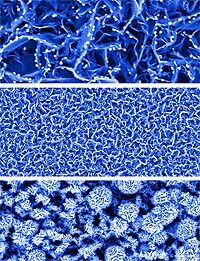‘It’s an inherently non-invasive way to estimate glucose content in the body,’ said Jonathan Claussen, a former Purdue University doctoral student and now a research scientist at the US Naval Research Laboratory. ‘Because it can detect glucose in the saliva and tears, it’s a platform that might eventually help to eliminate or reduce the frequency of using pinpricks for diabetes testing. We are proving its functionality.’
According to a statement, the sensor has three main parts: layers of nanosheets resembling tiny rose petals made of graphene; platinum nanoparticles; and the enzyme glucose oxidase.

Each so-called petal contains a few layers of stacked graphene. The edges of the petals have dangling, incomplete chemical bonds — defects where platinum nanoparticles can attach. Electrodes are formed by combining the nanosheet petals and platinum nanoparticles. Then the glucose oxidase attaches to the platinum nanoparticles. The enzyme converts glucose to peroxide, which generates a signal on the electrode.
‘Typically, when you want to make a nanostructured biosensor, you have to use a lot of processing steps before you reach the final biosensor product,’ said Anurag Kumar, a doctoral student who led the project with Claussen. ‘That involves lithography, chemical processing, etching and other steps. The good thing about these petals is that they can be grown on just about any surface, and we don’t need to use any of these steps, so it could be ideal for commercialisation.’
In addition to diabetes testing, the technology might be used for sensing a variety of chemical compounds to test for other medical conditions.
‘Because we used the enzyme glucose oxidase in this work, it’s geared for diabetes,’ Claussen said. ‘But we could just swap out that enzyme with, for example, glutemate oxidase, to measure the neurotransmitter glutamate to test for Parkinson’s and Alzheimer’s, or ethanol oxidase to monitor alcohol levels for a breathalyser. It’s very versatile, fast and portable.’
The technology is able to detect glucose in concentrations as low as 0.3 micromolar, which is claimed to be more sensitive than other electrochemical biosensors based on graphene or graphite, carbon nanotubes and metallic nanoparticles.
The sensor is able to distinguish between glucose and signals from other compounds that often cause interference in sensors: uric acid, ascorbic acid and acetaminophen, which are commonly found in the blood. Unlike glucose, these compounds are electroactive, generating an electrical signal without the presence of an enzyme.
Glucose by itself doesn’t generate a signal but must first react with the enzyme glucose oxidase. Glucose oxidase is used in commercial diabetes test strips for conventional diabetes meters that measure glucose with a finger pinprick.
The findings are detailed in a research paper being published this week in the journal Advanced Functional Materials.
The paper was written by Claussen; Kumar; Timothy Fisher, a Purdue professor of mechanical engineering; D Marshall Porterfield, a professor of agricultural and biological engineering; and Purdue researchers David B Jaroch, M Haseeb Khawaja and Allison B Hibbard.




Red Bull makes hydrogen fuel cell play with AVL
Formula 1 is an anachronistic anomaly where its only cutting edge is in engine development. The rules prohibit any real innovation and there would be...